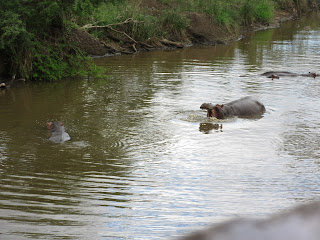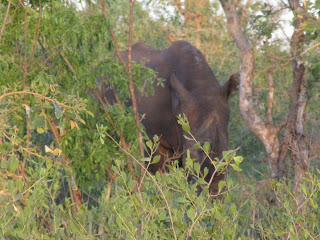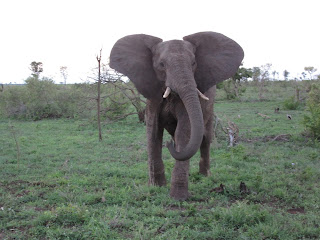We had tried last January to make a reservation inside Kruger National Park at the Crocodile Bridge Rest Camp but there was nothing left available. As it turned out, we lucked out that we were able to make reservations to stay instead for three nights at the Crocodile Bridge Safari Lodge located less than a mile outside the Crocodile River Entrance Gate to Kruger. The place was heavenly, the owners pulled out all the stops to make us and their other guests welcome and the location couldn't have been beat. Look for photos of our stay there in an upcoming post and you'll see why we loved it so much! While eating breakfast on the patio overlooking Crocodile River, we saw water buffalo just a hundred feet or so away. The owners reported seeing elephants and other large mammals just outside their property at various times of the day.
After filling out forms to enter the park and having a guard superficially check our car for weapons, alcohol, etc, we were waived through at 9. Back in August, we had purchased two Wild Card passes online that allowed daily entry to the park as well as admission to park sights all over South Africa for a full year. They were cheaper surprisingly than paying for the few days we'd be at Kruger.

After filling out forms to enter the park and having a guard superficially check our car for weapons, alcohol, etc, we were waived through at 9. Back in August, we had purchased two Wild Card passes online that allowed daily entry to the park as well as admission to park sights all over South Africa for a full year. They were cheaper surprisingly than paying for the few days we'd be at Kruger.
Our plan for the day was to drive from Crocodile Bridge in the far southeast area of the park north to one of the usually most prolific game viewing areas of the park around Lower Sabie. We detoured west though, initially, to go to the Hippo Pools but there were no hippos to be found there unfortunately.
Instead we saw plenty of impalas which had also been the most common animal we'd seen yesterday afternoon on our drive through part of the park.
More warthogs:
We couldn't get over the number of downed trees everywhere we looked.
Termite mounds were also a common sight on this stretch of road heading west.
I had seen gnus in our local zoo before but never realized their official name is actually Blue Wildebeest. They are called gnus because that is the sound they snort when they're alarmed!
According to the park guide I had bought, a common sight is that of just one male wildebeest stationed under a shady tree defending his territory hoping for a chance to mate. Males and females weigh 550 and 400 pounds respectively.
Finally, we spotted a hippo and could check that off the list of mammals in the back of our guide - yeah!
Hippos generally spend all day in the water, while at night they cover many miles feeding on short grass. The 3,300 pound animals can run extremely fast so it's dangerous to get between one and water.
We observed a herd of giraffes in the distance and then more, including a baby one, closer up as we began heading north toward Lower Sabie, located about 20 miles away.
We had seen other carcasses before this but this one had been picked clean.
Next we noticed our first vervet monkeys with some female nyalas and warthogs all together. Vervet monkeys only weigh about ten pounds and spend all their time in trees near rivers using them for food, safety and shelter. It was interesting to read that when they raise their eyebrows, the monkeys signal both fear and aggression.

We constantly had to slow down for animals, especially impalas, to cross the road in front of us as they had the right of way. We saw lots of birds in trees but we didn't have either binoculars of a bird field guide identifying them unfortunately. The adult plains zebras in Kruger had brown stripes unlike their adult counterparts in Kenya who had black stripes.
Predators are confused by zebras' stripes as, when a herd is bunched together, it looks like a single unit. Zebras often mix with impalas and wildebeests in open grassland where their sharp senses are of benefit to the entire group against surprise attack.
Part of a group of seven wildebeests grazing in the low grasses:
The trees in this area were all very low lying with a maximum of about eight feet in height.
More plains or Burchell's zebras:
Steven, with his eagle eyes, detected in the distance a whole herd of elephants most of whom were in single file.
We were so excited when we saw these four rhinos as that had meant we'd now seen all the Big Five animals - rhinos, lions, elephants, leopards and buffalo - that most visitors to Africa's game parks give their eyeteeth to see. The rhinos were the only one of the Big Five we'd not caught a glimpse of in Kenya's Maasai Mara. We hoped to discover still the other members of the Big Five here in Kruger but it was early days yet.
There are both black and so-called white rhinos but I can't tell you which ones these were! White Rhinos, the larger of the two, have a square lip, perfect for grazing so therefore is mostly found in the open savannah. Calves always walk in front of the mother. Black Rhinos have a hooked lip used for browsing and are more aggressive than the White Rhinos. Black Rhino calves follow behind their mothers.
Though these individual lilac-colored flowers were a common sight along the road, we didn't notice any other flowers.
We took a short detour to the Nthandanyathi Viewing Area as that was the first opportunity we'd been allowed out of the car all morning.
The hide was set up to view hippos in the waterhole. All I can say is I sure you want to see lots of hippos pictures as we were so thrilled watching a group of five hippos mostly loll around in the water. 'Mostly' is the operative word here as there was plenty of interaction among the hippos too!
One of my all time favorite pictures I've taken:
I was so glad I had my inexpensive Canon focused on these two hippos facing off against each other at the perfect moment.
Back on the road again, we saw a car in front of us stop but we didn't know what they'd discovered until we looked up in the tree and caught sight of this African fish-eagle. The eagles apparently have a magnificent ringing call but we didn't hear it. They seize fish near the water surface with their talons and eat large ones on the ground.
We stopped a bit later at the Lower Sabie Rest Camp for a few minutes to get a pop and ice cream as it had been really hot all morning. I loved how the bathrooms were referred to as 'Ablutions' as I hadn't heard that term in a long time!
The store had both kudu and warthog sausages but we weren't that hungry!
From the Mugg and Bean - a popular restaurant chain in South Africa - we spent a few minutes relaxing in super comfy chairs watching more hippos on the banks of the Sabie River.
We found another quiet spot to enjoy the sandwiches I had made this morning back at the lodge. The owners there had thought of everything and had equipped the outdoor guest kitchen with saran wrap, foil and even sandwich bags for their guests.
Yet more elephants to admire. Maybe others would have had their fill by then of all the animals but not us as they still never failed to impress us.
We wondered what everyone had gathered to look at when we saw all these cars. From our vantage point, though, we didn't observe a thing.
For almost the next hour of driving, there were no animals to be seen except for one elephant and two giraffes, not even the omnipresent impalas. It was perhaps due to its being the hottest part of the day or the very thick undergrowth made it very tough to detect anything.
Alas, a poor wildebeest. We determined what mammal it was because of the shape of its horns.
Easy to figure out we had entered the Sabie River Thickets eco-zone as the terrain changed hugely when we came across these huge boulders.
We were surprised that after three hours of driving yesterday and already six more hours today, we hadn't seen one ranger apart from those at the gates and rest camps.
We only spotted a spotted hyena (Sorry, I couldn't resist!) when we asked a parked car's driver what he was looking at. Otherwise, we'd never have noticed it sleeping in the grass. The hyena marked the 13th of the 43 mammals we'd seen that were listed in the guide.
Hyenas, according to our guide, are social mammals and live in big groups headed by a large matriarch. They are very effective predators but are also known as scavengers. Hyenas' distinctive 'whooo-oop' call can be heard at night.
Large termite mounds:
This was the first flower I'd spied in hours despite having my eyes glued to the road and the bush on either side.
Steven and I remarked we hadn't seen any cars in the last 90 plus minutes of driving. We hadn't come very far as the speed limit on these dirt roads was just 25 mph. Meanwhile though, we'd been keeping a close eye on the time and the roads to take as we needed to be back at the Crocodile Bridge Entrance Gate by 4:15 in time for a three hour Sunset Drive led by a park ranger at 4:30.
This impala stood absolutely motionless in the road for several minutes.
This was one of many trees that almost totally blocked the roads and made driving more challenging for Steven.
There were several clumps of these lovely, pinkish-red plants in the same small area.
There were more cars here than we'd seen in hours. Even though park rules dictated that a lane always be kept open for cars to pass, none of the cars moved so we were at a complete standstill. Understandably, horns were also a complete no-no as they would interfere with the animals. One of the drivers mentioned there were lions but we never saw them. At least we'd come across them in Kenya so we didn't mind too much missing them now.
About 3:15. we exited the park at Crocodile Bridge Entrance Gate to drive to the nearby town of Komatipoort to grab some meat to cook at dinner on the lodge's braai, i.e barbecue. Rushing back to the park for the game drive, we managed to see this female bushbuck by the office. Normally the animals are found alone in thickets and dense undergrowth so we were lucky.
Jacob, our ranger on the three hour jeep tour that we'd reserved in August, told the group that park management used to allow for elephants in the park to be culled. Since elephants 'have rights too', their numbers had doubled to 6,700 since 1994. Male elephants have square heads, he said, while females have round heads. Elephants have no natural predators. Birds follow elephants because they scare up insects which the birds eat.
Jacob mentioned that the bulls push the big trees down and feed off the lower branches. That explained why there were so many dead trees in the park.
Jacob stated female impalas don't have horns and have a 5-6 month gestation. The numbers of impalas are so large in the park because they have babies yearly, normally in November. Unlike other antelopes, impalas eat all over and don't have to migrate.
Jacob pointed out that this tree was still alive even though the roots were still visible because elephants weren't able to reach the top of the tree.
A spoon bill stork:
Jacob remarked that hippos, water buffalo and crocodiles weren't 'kind' animals as they kill so many people in Africa. He added that hippos roam on land at night. Lions, elephants and 'others' will leave people alone unless provoked.
2015 was a very dry season so lots of buffaloes and hippos died because they couldn't travel great distances to feed in areas with available grass and water. The drought reduced the population of many of the animals. The rainy season results in grass, i.e. food, production which in turn means population increases in the park.
These marula trees bear fruit that elephants love and are rich in Vitamin C. We had spotted marula jam in the store but there weren't any samples for us to taste.
Jacob remarked that herbalists or African doctors known as 'sango mas' take the bark from these fever trees as well as other trees to make medicine. If you mix fever trees and Vaseline, 'you will be sure to shine and stand out in a crowd,' Jacob said. I thought to myself who would want to though! He added that, according to the sango mas, those with sinus issues benefit from burning and then inhaling elephant poop as elephants are extremely picky and only eat good plants. Anyone wanting to try it, please let me know if it works as I won't be trying it anytime soon!
We and the other passengers in the jeep thought that these two giraffes were simply cuddling or 'necking'! But Jacob indicated that in fact that they were both males and were battling for supremacy. They would continue fighting until one was exhausted. The 'winner' would then be the dominant one when a female giraffe came along; the 'loser' would back off.
Jacob informed us that giraffes can see up to 2 kms away and that impalas and wildebeests stay close to them so they can be alerted when predators appear.
To my ignorant eyes, they looked so endearing and didn't appear to be fighting at all.
Jacob revealed that elephants vary in color from brown to black depending on the type of mud they cover themselves with. The mud acts as a natural sunscreen and keeps ticks away.
This may again be a case of TMI but each elephant's 'dropping' weighs about 22 pounds and they drop 10 times a day! They feed on a single tree for one hour. Smaller animals called 'bowsers' are only there for a few minutes because trees release tannins that bowsers can't absorb.
The trumpeting sounds elephants make can be heard up to nine miles away. They have poor eyesight but great hearing. Jacob joked that you know they're 'African elephants' and not Indian elephants because their ears are like a map of Africa. 'Egypt is at the top, Europe is in the sky and Capetown, South Africa's southernmost city, is at the bottom!'
An elephant's gestation is 22 months and lifespan is 65 years. They reach their full size between 35 and 45 years of age and begin breeding at age 20.
I had never known that zebras have their own 'barcodes' or unique stripes like a hand print, Jacob said. When females give birth after 12.5 months of gestation, it's done away from the herd for two to three days so that the baby can recognize its mother's scent. The mother also makes sure the baby eats a bit of her poop so the baby receives the mother's antibodies.
Baby zebras, who are born white and develop their stripes later, live until they're 35 years of age.
When we noticed these White Rhinos, Jacob informed us that their gestational period is 16 months long and lifespan is 45 years. They root on the ground for grass because they have such a heavy head.
In the southern part of Kruger, sunset, known as 'African fire', was at 6.
A pregnant zebra:
Jacob stated that the only two animals who breed during the dry season were the elephants and giraffes.
Jacob stooped the jeep so we could watch this male dung beetle for several minutes push the ball of dung across the road while a female dung beetle hung on for dear life.
More elephant trivia for you: They prefer eating acacia trees because they're so sweet. Babies normally weigh a staggering 330 pounds at birth. Adult males weigh in at 5-6 tons and female adults are 'only' 2-3 tons!
Jacob noted that this female probably lost one tusk when she was being too aggressive.
Steven and I thought that the Sunset Tour should have started a lot earlier as we couldn't spy any other animals for the remaining 90 minutes of the tour. We got back to the gate at 8 and were glad the lodge was only a two minute drive away as we were plumb tuckered out, having started our day in the park almost 12 hours ago. We collapsed into bed after grilling our dinner on the 'braai' and enjoying the delicious vegetable dishes the owner's wife had prepared for everyone.
Posted on January 14th, 2017 from Littleton, Colorado.











































































































































White Rhinos are really Wide Lip Rhinos, they are not necessarily white. You sure did see a lot of nice elephants. I want to be a zebra in another life. They are so neat looking. Lil Red
ReplyDelete